韩国文化礼仪(英语)
- 格式:pptx
- 大小:2.26 MB
- 文档页数:12
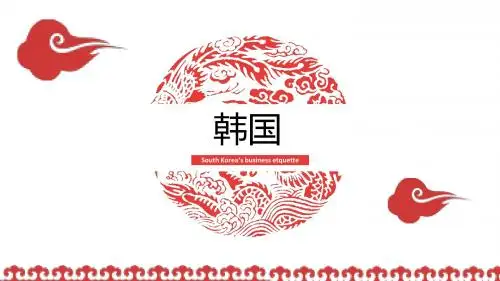
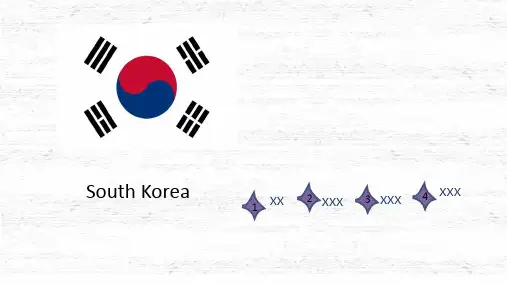
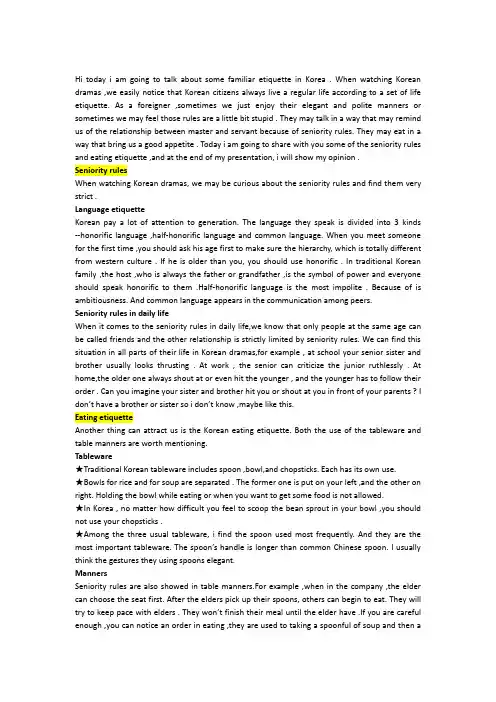
Hi today i am going to talk about some familiar etiquette in Korea . When watching Korean dramas ,we easily notice that Korean citizens always live a regular life according to a set of life etiquette. As a foreigner ,sometimes we just enjoy their elegant and polite manners or sometimes we may feel those rules are a little bit stupid . They may talk in a way that may remind us of the relationship between master and servant because of seniority rules. They may eat in a way that bring us a good appetite . Today i am going to share with you some of the seniority rules and eating etiquette ,and at the end of my presentation, i will show my opinion .Seniority rulesWhen watching Korean dramas, we may be curious about the seniority rules and find them very strict .Language etiquetteKorean pay a lot of attention to generation. The language they speak is divided into 3 kinds --honorific language ,half-honorific language and common language. When you meet someone for the first time ,you should ask his age first to make sure the hierarchy, which is totally different from western culture . If he is older than you, you should use honorific . In traditional Korean family ,the host ,who is always the father or grandfather ,is the symbol of power and everyone should speak honorific to them .Half-honorific language is the most impolite . Because of is ambitiousness. And common language appears in the communication among peers.Seniority rules in daily lifeWhen it comes to the seniority rules in daily life,we know that only people at the same age can be called friends and the other relationship is strictly limited by seniority rules. We can find this situation in all parts of their life in Korean dramas,for example , at school your senior sister and brother usually looks thrusting . At work , the senior can criticize the junior ruthlessly . At home,the older one always shout at or even hit the younger , and the younger has to follow their order . Can you imagine your sister and brother hit you or shout at you in front of your parents ? I don’t have a brother or sister so i don’t know ,maybe like this.Eating etiquetteAnother thing can attract us is the Korean eating etiquette. Both the use of the tableware and table manners are worth mentioning.Tableware★Traditional Korean tableware includes spoon ,bowl,and chopsticks. Each has its own use.★Bowls for rice and for soup are separated . The former one is put on your left ,and the other on right. Holding the bowl while eating or when you want to get some food is not allowed.★In Korea , no matter how difficult you feel to scoop the bean sprout in your bowl ,you should not use your chopsticks .★Among the three usual tableware, i find the spoon used most frequently. And they are the most important tableware. The spoon’s handle is longer than common Chinese spoon. I usually think the gestures they using spoons elegant.MannersSeniority rules are also showed in table manners.For example ,when in the company ,the elder can choose the seat first. After the elders pick up their spoons, others can begin to eat. They will try to keep pace with elders . They won’t finish their meal until the elder have .If you are careful enough ,you can notice an order in eating ,they are used to taking a spoonful of soup and then amouthful of rice.And after that they begin to eat what they want .ConclusionThough these rules seems very complicated and troublesome, and we sometimes just want to ask them why they don’t have a relaxing meal?I think ,the Korean have get used to them just like we Chinese get used to our own etiquette.Seniority is not just in the screen in Korea ,it happens everyday and everywhere.Actually ,Korean people is now facing a dilemma that whether they keep this seniority rules in today’s democratic and equal world. The society criticized the rules a lot after the accident of Sewol where the rescuer saved the headmaster first and left more than 300 students stuck in the sinking ship. Maybe is not the main reason for the accident ,but it truly alert the society to this issue. China has this dilemma too . To reserve traditional culture or to dispose.I think,we should take the essence and discard the dregs. Adapt our opinion and culture to the rapidly developed world,otherwise our culture regression may be caused or our cultural root will be lost .。

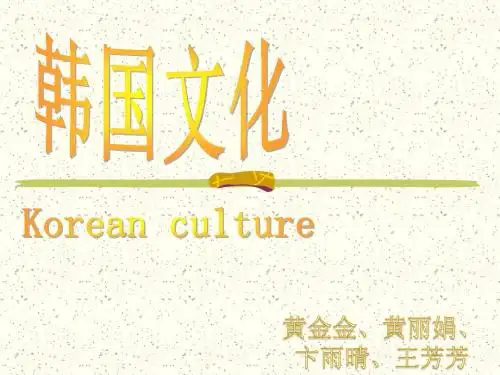
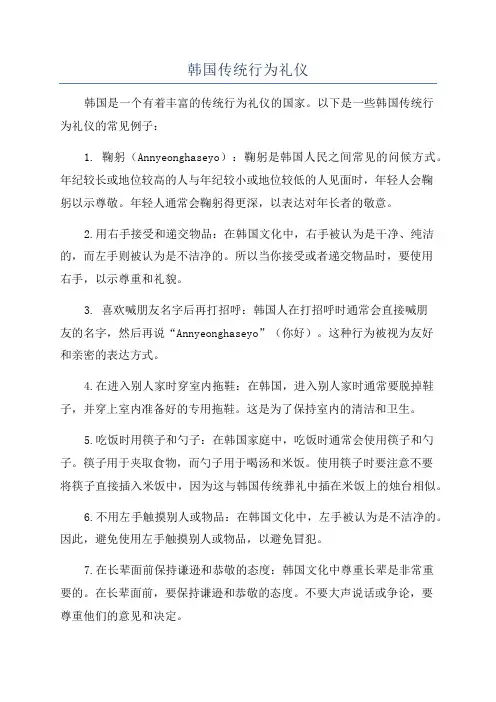
韩国传统行为礼仪韩国是一个有着丰富的传统行为礼仪的国家。
以下是一些韩国传统行为礼仪的常见例子:1. 鞠躬(Annyeonghaseyo):鞠躬是韩国人民之间常见的问候方式。
年纪较长或地位较高的人与年纪较小或地位较低的人见面时,年轻人会鞠躬以示尊敬。
年轻人通常会鞠躬得更深,以表达对年长者的敬意。
2.用右手接受和递交物品:在韩国文化中,右手被认为是干净、纯洁的,而左手则被认为是不洁净的。
所以当你接受或者递交物品时,要使用右手,以示尊重和礼貌。
3. 喜欢喊朋友名字后再打招呼:韩国人在打招呼时通常会直接喊朋友的名字,然后再说“Annyeonghaseyo”(你好)。
这种行为被视为友好和亲密的表达方式。
4.在进入别人家时穿室内拖鞋:在韩国,进入别人家时通常要脱掉鞋子,并穿上室内准备好的专用拖鞋。
这是为了保持室内的清洁和卫生。
5.吃饭时用筷子和勺子:在韩国家庭中,吃饭时通常会使用筷子和勺子。
筷子用于夹取食物,而勺子用于喝汤和米饭。
使用筷子时要注意不要将筷子直接插入米饭中,因为这与韩国传统葬礼中插在米饭上的烛台相似。
6.不用左手触摸别人或物品:在韩国文化中,左手被认为是不洁净的。
因此,避免使用左手触摸别人或物品,以避免冒犯。
7.在长辈面前保持谦逊和恭敬的态度:韩国文化中尊重长辈是非常重要的。
在长辈面前,要保持谦逊和恭敬的态度。
不要大声说话或争论,要尊重他们的意见和决定。
8.在聚餐中等长辈开始吃饭才开始进食:在韩国的传统聚餐中,长辈通常会先开始吃饭,其他人则要等待长辈开始进食后才可以开始。
这是为了表达对长辈的尊重和礼貌。
9.在公共场所保持安静:在韩国的公共场所,要注意保持安静。
不要大声说话或喧闹,以避免干扰他人。
10.在公共交通工具上给需要座位的人让座:在公共交通工具上,如果有需要座位的人上车,年轻人通常会自觉让座给年长或有需要的人。
这是一种尊重和关心他人的表达方式。
总的来说,韩国传统行为礼仪强调对他人的尊重、关怀和慎言慎行。

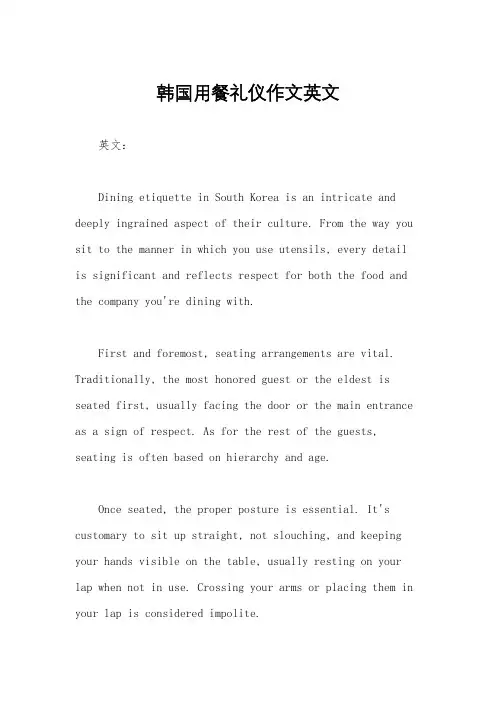
韩国用餐礼仪作文英文英文:Dining etiquette in South Korea is an intricate and deeply ingrained aspect of their culture. From the way you sit to the manner in which you use utensils, every detail is significant and reflects respect for both the food and the company you're dining with.First and foremost, seating arrangements are vital. Traditionally, the most honored guest or the eldest is seated first, usually facing the door or the main entrance as a sign of respect. As for the rest of the guests, seating is often based on hierarchy and age.Once seated, the proper posture is essential. It's customary to sit up straight, not slouching, and keeping your hands visible on the table, usually resting on your lap when not in use. Crossing your arms or placing them in your lap is considered impolite.When it comes to using utensils, chopsticks are the primary tool. They should be held towards the end, not in the middle or close to the food. It's also important not to point with chopsticks or leave them sticking verticallyinto a bowl of rice, as both actions are reminiscent of funeral rituals.Furthermore, noise should be kept to a minimum during the meal. Slurping or making loud chewing sounds is generally frowned upon, as it can be seen as disrespectful to the chef and other diners. Also, it's polite to wait until everyone has been served before starting to eat.In terms of conversation, topics such as politics, religion, and personal finances are usually avoided, especially with those you're not well acquainted with. Instead, light and neutral subjects are preferred to maintain a pleasant atmosphere.Lastly, it's customary to offer compliments to the host about the food. Expressing enjoyment of the meal showsappreciation for their effort and hospitality. Even ifthere's something you didn't particularly like, it's bestto find something positive to say.In summary, South Korean dining etiquette is a blend of respect, tradition, and courtesy. By following these customs, you not only show respect for the culture but also ensure a harmonious dining experience for everyone involved.中文:在韩国,用餐礼仪是他们文化中一个复杂而根深蒂固的部分。
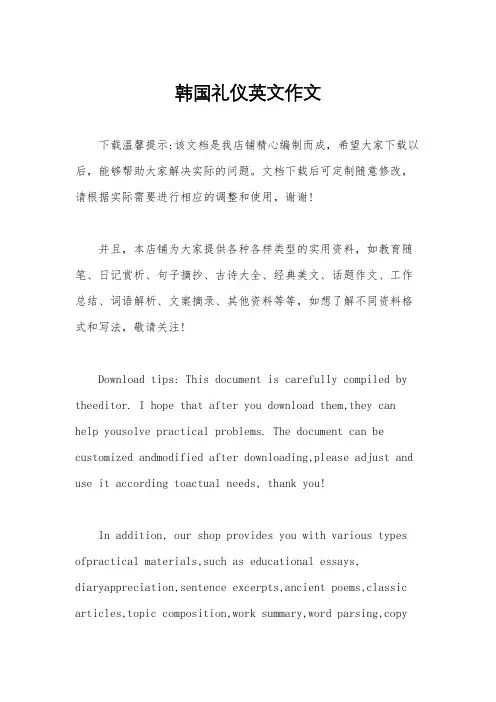
韩国礼仪英文作文下载温馨提示:该文档是我店铺精心编制而成,希望大家下载以后,能够帮助大家解决实际的问题。
文档下载后可定制随意修改,请根据实际需要进行相应的调整和使用,谢谢!并且,本店铺为大家提供各种各样类型的实用资料,如教育随笔、日记赏析、句子摘抄、古诗大全、经典美文、话题作文、工作总结、词语解析、文案摘录、其他资料等等,如想了解不同资料格式和写法,敬请关注!Download tips: This document is carefully compiled by theeditor. I hope that after you download them,they can help yousolve practical problems. The document can be customized andmodified after downloading,please adjust and use it according toactual needs, thank you!In addition, our shop provides you with various types ofpractical materials,such as educational essays, diaryappreciation,sentence excerpts,ancient poems,classic articles,topic composition,work summary,word parsing,copyexcerpts,other materials and so on,want to know different data formats andwriting methods,please pay attention!Koreans are very polite. They always bow when greeting each other.In Korea, respecting elders is very important. Young people should use respectful language and behavior towards the elderly.When having a meal, there are also certain etiquette rules. For example, you should wait until everyone is seated before starting to eat.Koreans are also particular about gift-giving. Choosing an appropriate gift is considered a sign of respect.Going to someone's home requires taking off your shoes. And you should be polite and respectful to the host.。
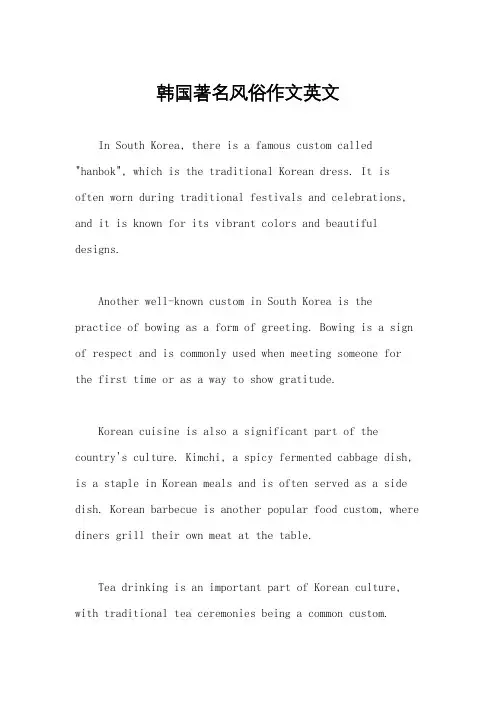
韩国著名风俗作文英文In South Korea, there is a famous custom called "hanbok", which is the traditional Korean dress. It is often worn during traditional festivals and celebrations, and it is known for its vibrant colors and beautiful designs.Another well-known custom in South Korea is thepractice of bowing as a form of greeting. Bowing is a sign of respect and is commonly used when meeting someone for the first time or as a way to show gratitude.Korean cuisine is also a significant part of the country's culture. Kimchi, a spicy fermented cabbage dish, is a staple in Korean meals and is often served as a side dish. Korean barbecue is another popular food custom, where diners grill their own meat at the table.Tea drinking is an important part of Korean culture, with traditional tea ceremonies being a common custom.Green tea is the most popular type of tea in Korea, and it is often served as a gesture of hospitality to guests.Korean traditional music, known as "gugak", is a cherished part of the country's cultural heritage. It includes various forms of music, dance, and rituals, and is often performed at traditional events and celebrations.In South Korea, the custom of giving and receivinggifts is an important part of social interactions. Gifts are often given as a way to show respect, gratitude, or to celebrate special occasions.Korean traditional dance, known as "jeongjae", is a graceful and expressive form of art that has been passed down through generations. It often incorporates colorful costumes and intricate movements to tell stories and convey emotions.。
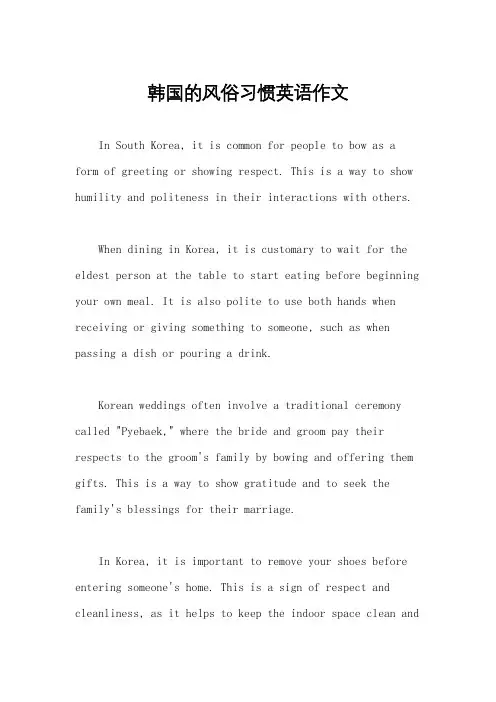
韩国的风俗习惯英语作文In South Korea, it is common for people to bow as a form of greeting or showing respect. This is a way to show humility and politeness in their interactions with others.When dining in Korea, it is customary to wait for the eldest person at the table to start eating before beginning your own meal. It is also polite to use both hands when receiving or giving something to someone, such as when passing a dish or pouring a drink.Korean weddings often involve a traditional ceremony called "Pyebaek," where the bride and groom pay their respects to the groom's family by bowing and offering them gifts. This is a way to show gratitude and to seek the family's blessings for their marriage.In Korea, it is important to remove your shoes before entering someone's home. This is a sign of respect and cleanliness, as it helps to keep the indoor space clean andfree from outdoor dirt.In Korean culture, it is common for people to address others using titles and honorifics based on age and social status. This shows respect for the person being addressed and is an important aspect of Korean language and communication.During traditional Korean holidays, such as Lunar New Year and Chuseok, it is customary for families to gatherand pay respects to their ancestors by holding memorial services and offering food and drinks at their ancestral graves. This is a way to honor and remember their family heritage.In South Korea, there is a strong emphasis on group harmony and consensus, so it is important to consider the feelings and opinions of others in social and work settings. This often involves a lot of indirect communication andnon-verbal cues to maintain harmony within the group.。
英语作文韩国礼仪Korean Etiquette。
Korean etiquette is an important aspect of Koreanculture and society. It is deeply rooted in Confucianism, which emphasizes respect for others, especially elders and those in authority. Understanding and practicing Korean etiquette is essential for anyone visiting or living in Korea.One of the most important aspects of Korean etiquetteis the concept of "sunbae" and "hoobae," which refers tothe senior-junior relationship. In Korean society, it is important to show respect to those who are older or in a higher position. This can be seen in the workplace, schools, and even in social settings. When addressing someone who is older or in a higher position, it is important to use honorific language and show deference.Another important aspect of Korean etiquette is theconcept of "jeong," which refers to the deep emotional bond between people. This concept emphasizes the importance of building and maintaining strong relationships with others. In Korean society, it is important to show care and consideration for others, and to prioritize the needs of the group over individual needs.In addition to the senior-junior relationship and the concept of "jeong," there are many other aspects of Korean etiquette that are important to be aware of. For example, when greeting someone, it is important to bow slightly and use both hands to offer a handshake. It is also important to remove your shoes before entering someone's home, and to never point with your fingers.When dining in Korea, there are also specific etiquette rules to follow. For example, it is important to wait for the eldest person to start eating before you begin. It is also important to use both hands when receiving or giving something to someone, and to never pour your own drink.Understanding and practicing Korean etiquette isessential for anyone visiting or living in Korea. By showing respect for others, building strong relationships, and following the specific etiquette rules, you can navigate Korean society with ease and show appreciation for the culture.In conclusion, Korean etiquette is deeply rooted in Confucianism and emphasizes respect for others, building strong relationships, and following specific etiquette rules. By understanding and practicing Korean etiquette, you can show respect for the culture and navigate Korean society with ease. Whether you are visiting or living in Korea, it is important to be aware of and follow Korean etiquette.。
韩国风俗英文作文英文:Korean culture is very unique and fascinating. As someone who has lived in Korea for several years, I have had the opportunity to experience many aspects of Korean culture, including their customs and traditions.One of the most notable customs in Korea is the bow. Koreans bow to show respect to others, whether it be to their elders, their boss, or even to strangers. The depth of the bow can vary depending on the situation, but it is always done with sincerity and humility. This practice is deeply ingrained in Korean culture and is a sign of the importance placed on respect and hierarchy.Another interesting aspect of Korean culture is the emphasis on communal dining. In Korea, it is common for people to share dishes and eat together, rather than ordering individual meals. This is a reflection of thecollectivist nature of Korean society, where the needs of the group are prioritized over the needs of the individual.Koreans also place a great deal of importance on education. Students in Korea often attend after-school academies called hagwons to supplement their education and improve their chances of getting into a good university. This focus on education is reflected in the high academic standards and achievements of Korean students.Overall, Korean culture is rich and diverse, with many unique customs and traditions that are worth experiencing. Whether it be the bow, communal dining, or the emphasis on education, these cultural practices reflect the values and beliefs of Korean society.中文:韩国文化非常独特而迷人。
韩国的辈分礼节英语作文Korean Hierarchy Etiquette。
In Korea, hierarchy and respect are deeply ingrained in the culture. It is important to understand the proper etiquette when interacting with people of different ages and positions. Here are some guidelines to follow:1. Use the appropriate title: When addressing someone who is older or higher in rank, it is important to use the appropriate title. For example, if someone is older than you, you should call them "unnie" (older sister) or "oppa" (older brother) if you are a woman or man respectively. If someone is higher in rank than you, you should use their title, such as "manager" or "director."2. Bowing: Bowing is a common form of showing respect in Korea. When meeting someone for the first time, it is customary to bow slightly. The depth of the bow depends on the person's age and position. A deeper bow is given tosomeone who is older or higher in rank.3. Handshakes: Handshakes are becoming more common in Korea, especially in business settings. However, it isstill important to follow the hierarchy etiquette. If you are meeting someone who is older or higher in rank, it is best to wait for them to offer their hand first.4. Gift-giving: Giving gifts is a common practice in Korea, especially during holidays and special occasions. When giving a gift, it is important to choose something appropriate for the person's age and position. For example, a younger person may give a small gift to an older person as a sign of respect.5. Sitting and standing: When sitting or standing in the presence of someone who is older or higher in rank, it is important to show respect by sitting or standing up straight and avoiding slouching or crossing your legs.In conclusion, understanding and following the hierarchy etiquette in Korea is important for buildingrelationships and showing respect. By using the appropriate titles, bowing, giving gifts, and showing proper posture, you can demonstrate your respect for others and build strong connections in both personal and professional settings.。
韩国著名风俗作文英文英文:Korean culture is full of unique customs and traditions that have been passed down for generations. As a Korean, I am proud to share some of these customs with you.One of the most well-known Korean customs is bowing. In Korea, bowing is a sign of respect and is used in various situations such as greeting someone, apologizing, or showing gratitude. The depth of the bow and the duration of the bowing can vary depending on the situation and the relationship between the individuals.Another interesting custom is the use of honorifics. In Korean, there are different levels of politeness and respect that are reflected in the language. For example, when speaking to someone older or in a higher position, it is common to use honorific language to show respect. This can include adding suffixes to the end of words or usingdifferent verb endings.One of my favorite Korean customs is the sharing of food. In Korea, it is common for people to share dishes and eat communally. This not only fosters a sense of community and togetherness, but it also allows for the opportunity to try a variety of different foods.Overall, Korean culture is rich in customs and traditions that reflect a deep sense of respect, community, and hospitality.中文:韩国文化充满了独特的习俗和传统,这些习俗和传统已经代代相传。